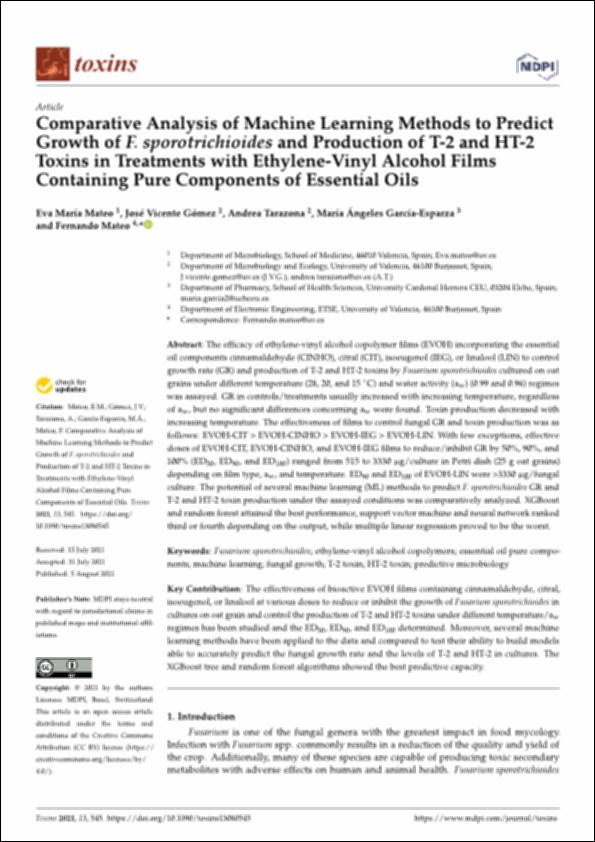Please use this identifier to cite or link to this item:
http://hdl.handle.net/10637/13695Comparative analysis of machine learning methods to predict growth of "F. sporotrichioides" and production of T-2 and HT-2 toxins in treatments with Ethylene-Vinyl alcohol films containing pure components of essential oils
| Title: | Comparative analysis of machine learning methods to predict growth of "F. sporotrichioides" and production of T-2 and HT-2 toxins in treatments with Ethylene-Vinyl alcohol films containing pure components of essential oils |
| Authors : | Mateo Jiménez, Eva María Gómez, José Vicente Tarazona, Andrea García Esparza, María Ángeles Mateo Jiménez, Fernando |
| Keywords: | Biofilms.; Machine learning.; Toxinas y antitoxinas.; Biofilmes.; Aprendizaje automático (Inteligencia artificial); Essences and essential oils.; Toxins.; Polímeros.; Polymers.; Esencias. |
| Publisher: | MDPI |
| Citation: | Mateo, E. M., Gómez, J.V., Tarazona, A., García-Esparza, M.Á. & Mateo, F. (2021). Comparative analysis of machine learning methods to predict growth of "F. sporotrichioides" and production of T-2 and HT-2 toxins in treatments with Ethylene-Vinyl alcohol films containing pure components of essential oils. Toxins, vol. 13, i. 8 (05 aug.), art. 545. DOI: http://dx.doi.org/10.3390/toxins13080545 |
| Abstract: | The efficacy of ethylene-vinyl alcohol copolymer films (EVOH) incorporating the essential oil components cinnamaldehyde (CINHO), citral (CIT), isoeugenol (IEG), or linalool (LIN) to control growth rate (GR) and production of T-2 and HT-2 toxins by Fusarium sporotrichioides cultured on oat grains under different temperature (28, 20, and 15 C) and water activity (aw) (0.99 and 0.96) regimes was assayed. GR in controls/treatments usually increased with increasing temperature, regardless of aw, but no significant differences concerning aw were found. Toxin production decreased with increasing temperature. The effectiveness of films to control fungal GR and toxin production was as follows: EVOH-CIT > EVOH-CINHO > EVOH-IEG > EVOH-LIN. With few exceptions, effective doses of EVOH-CIT, EVOH-CINHO, and EVOH-IEG films to reduce/inhibit GR by 50%, 90%, and 100% (ED50, ED90, and ED100) ranged from 515 to 3330 g/culture in Petri dish (25 g oat grains) depending on film type, aw, and temperature. ED90 and ED100 of EVOH-LIN were >3330 g/fungal culture. The potential of several machine learning (ML) methods to predict F. sporotrichioides GR and T-2 and HT-2 toxin production under the assayed conditions was comparatively analyzed. XGBoost and random forest attained the best performance, support vector machine and neural network ranked third or fourth depending on the output, while multiple linear regression proved to be the worst. |
| Description: | Este artículo se encuentra disponible en la página web de la revista en la siguiente URL: https://www.mdpi.com/2072-6651/13/8/545 Este artículo pertenece al número especial "Selected Papers from the V Workshop of the Spanish National Network on Mycotoxins and Toxigenic Fungi and Their Decontamination Processes (MICOFOOD), 10?11 December 2020". |
| URI: | http://hdl.handle.net/10637/13695 |
| Rights : | http://creativecommons.org/licenses/by/4.0/deed.es |
| ISSN: | 2072-6651 (Electrónico) |
| Issue Date: | 5-Aug-2021 |
| Center : | Universidad Cardenal Herrera-CEU |
| Appears in Collections: | Dpto. Farmacia |
Items in DSpace are protected by copyright, with all rights reserved, unless otherwise indicated.


